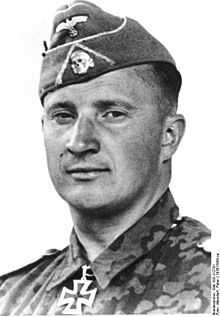Ernst Häußler
| Ernst Häußler | |
|---|---|
 | |
| Born |
31 March 1914 Württemberg |
| Died |
14 July 1979 (aged 65) Öhringen |
| Allegiance |
|
| Service/branch |
|
| Years of service | 1933–45 |
| Rank | Standartenführer |
| Unit |
3rd SS Panzer Division Totenkopf 17th SS Panzergrenadier Division Götz von Berlichingen |
| Battles/wars | World War II |
| Awards |
Knight's Cross of the Iron Cross German Cross in Gold Iron Cross 1st Class Iron Cross 2nd Class Infantry Assault Badge in Bronze Wound Badge in Silver Eastern Front Medal 1941/42 |
Ernst Häußler[Note 1] (31 March 1914 – 14 July 1979) was a Standartenführer (Colonel), in the Waffen SS during World War II. He was awarded the Knight's Cross of the Iron Cross to recognize extreme battlefield bravery or successful military leadership by Nazi Germany during World War II.
Early life
Häußler was born on 31 March 1914 at Württemberg. He volunteered to join the SS in May 1933 and given the service number 217,862. His NSDAP party number was 1,150,866. After enlistment, he was assigned to the SS Standarte Deutschland. He was promoted to Unterscharführer in April 1935, and the following year was selected to be an officer and posted to the SS-Junkerschule at Braunschweig.[1] After graduation he was posted back to the SS-VT in Oberbayern and served at Dachau concentration camp between 1936 and 1939.
World War II
In 1940, Häußler was posted to the newly formed SS Totenkopf Division as the commander of its 5th company. He was awarded the Iron Cross (2nd class) in June 1940 and the Wound Badge in Black for his first wound of the war. He participated in the invasion of the Soviet Union (Operation Barbarossa) and was awarded the Iron Cross (1st class) in July 1941. He was later awarded the Eastern Front Medal. In April 1943 he was awarded the German Cross in Gold and was then promoted to Sturmbannführer (Major) in June 1943. This was followed by the award of the Knight's Cross in August 1943.[1]
Häußler went on to command the 1st SS Totenkopf Reserve Battalion before a posting as a battalion commander in the 17th SS Panzergrenadier Division Götz von Berlichingen ( The name referred to the 15th century German knight who had, after losing his right hand in battle, wore an iron prosthetic hand. In keeping with this, the division's emblem was a clenched iron fist). He later returned to the SS Totenkopf, as the commander of 5th SS Panzer Grenadier Regiment Totenkopf.[1][2]
Later life
Häußler survived the war and died of heart failure on 14 July 1979 at Öhringen.[1]
Notes
- ↑ His name, in German, is spelled with a "sharp S"; see ß.
References
- Citations
- Bibliography
- Fellgiebel, Walther-Peer (2000). Die Träger des Ritterkreuzes des Eisernen Kreuzes 1939–1945 – Die Inhaber der höchsten Auszeichnung des Zweiten Weltkrieges aller Wehrmachtteile [The Bearers of the Knight's Cross of the Iron Cross 1939–1945 — The Owners of the Highest Award of the Second World War of all Wehrmacht Branches] (in German). Friedberg, Germany: Podzun-Pallas. ISBN 978-3-7909-0284-6.
- Henschler Henri & Fay Will, Armor Battles of the Waffen-SS, 1943-45 Stackpole Books, 2003. ISBN 0-8117-2905-2
- Mitcham, Samuel W (2007). Retreat to the Reich : the German defeat in France, 1944. Mechanicsburg, PA: Stackpole Books. ISBN 978-0-8117-3384-7.
- Scherzer, Veit (2007). Die Ritterkreuzträger 1939–1945 Die Inhaber des Ritterkreuzes des Eisernen Kreuzes 1939 von Heer, Luftwaffe, Kriegsmarine, Waffen-SS, Volkssturm sowie mit Deutschland verbündeter Streitkräfte nach den Unterlagen des Bundesarchives [The Knight's Cross Bearers 1939–1945 The Holders of the Knight's Cross of the Iron Cross 1939 by Army, Air Force, Navy, Waffen-SS, Volkssturm and Allied Forces with Germany According to the Documents of the Federal Archives] (in German). Jena, Germany: Scherzers Miltaer-Verlag. ISBN 978-3-938845-17-2.
| |||||||||||||||||||||||||||||||||||||||||||||||||||||||||||||||||||||
